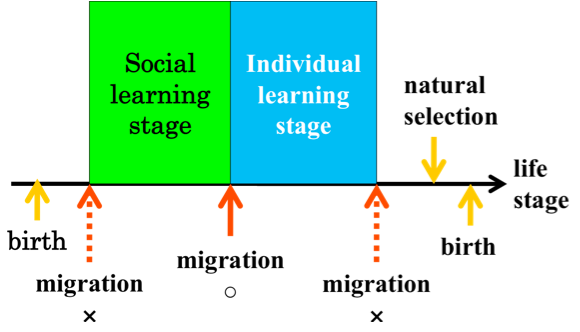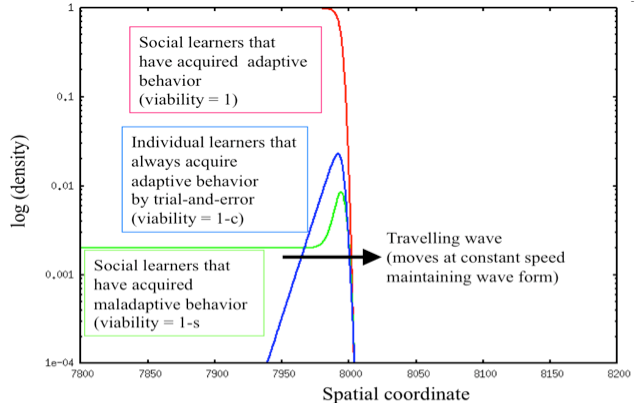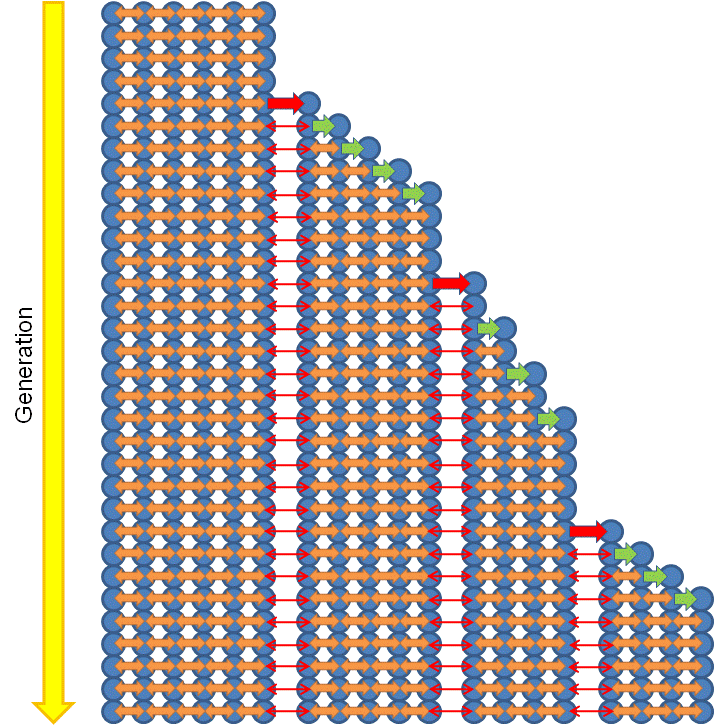|
|

Research Title:
Research on Evolutionary Models of Human Learning Abilities
Research Organization:
Team Leader
- Kenichi Aoki, Professor, Population Biology, Graduate School of Science, University of Tokyo
Co-investigators
- Kohkichi Kawasaki, Professor, Mathematical Biology, Faculty of Culture and Information Science, Doshisha University,
- Joe Yuichiro Wakano, Associate Professor, Mathematical Biology, Institute for Advanced Study of Mathematical Sciences, Meiji University
- Ryosuke Kimura, Project Associate Professor, Molecular Anthropology, Transdisciplinary Research Organization for Subtropics and Island Studies, University of the Ryukyus
- Wataru Nakahashi, Research Promoter, Meiji Institute for Advanced Study of Mathematical Sciences, Meiji University
- Yutaka Kobayashi, Postdoctoral Fellow, Department of Biological Sciences, Graduate School of Science, The University of Tokyo
Overseas Collaborators
- Marcus W. Feldman, Professor, Population Biology, Stanford University, USA
- Laurent Lehmann, Assistant Professor, Population Biology, Neuchatel University, Switzerland
Invited Researchers
- Makoto K. Shimada, Senior Assistant Professor, Institute for Comprehensive Medical Science, Fujita Health University
- Nobuyuki Takahashi, Associate Professor, Social Psychology, Graduate School of Letters and Center for Experimental Research in Social Sciences, Hokkaido University
- Shiro Horiuchi, Research Fellow, Organization for the Strategic Coordination of Research and Intellectual Property, Meiji University
Research Objectives
We will provide theoretical support for the “learning hypothesis” that the replacement of Neanderthals (Homo neanderthalensis) by humans (H. sapiens) is attributable to innate differences in learning abilities between the two hominid species. Towards this goal, we will use evolutionary models to deduce the conditions under which abilities supportive of social learning (e.g. learning from others by imitation, teaching) and/or individual learning (e.g. learning by oneself by trial-and-error, “creativity”) evolve as adaptations to a changing environment. With reference to data on climate change and other environmental variables supplied by B02, we will then attempt to explain why these abilities evolved to a high level in humans but presumably did not in Neanderthals. Furthermore, with the expectation that differences in learning abilities should be most directly reflected in differences in cultural evolutionary rate, we will examine whether such a causal relation can be discerned in the archaeological record provided by A01. A complementary goal is to identify the genes contributing to the highly-developed learning abilities of humans, based on statistical analyses of molecular population genetic data, and to locate possible region(s) of the brain where these genes are expressed, with reference to the functional map for present-day humans provided by C02. In addition, we will use both evolutionary models and molecular population genetic data to investigate the pattern, speed, and routes of range expansion of humans within and outside of Africa.
Research Methods
We will describe and analyze mathematical models dealing with the effects of environmental change on the evolution of social learning and individual learning abilities. In particular, we will study stepping-stone models (habitats are arranged like beads on a necklace, see for example Aoki & Nakahashi 2008, Theoretical Population Biology 74, 356-368) and reaction-diffusion models (habitats are distributed continuously, Shigesada & Kawasaki 1997 Biological Invasions, Oxford University Press) incorporating spatial environmental heterogeneity, and will derive the conditions for the evolution of learning abilities (especially individual learning abilities) during range expansion into an environmentally heterogeneous world. Moreover, we will review the special features of range expansion of humans relative to that of other biological species including Neanderthals and H. erectus, in order to add precision to the above evolutionary models. This we will do from the standpoints of mathematical ecology and molecular population genetics, focusing on such factors as aggregation toward favorable environments or invasion of inhospitable environments, density-dependent migration, and changes in migration rate per se.
By juxtaposing the results obtained from the above theoretical studies with quantitative data on environmental variability (e.g., between habitats) provided by B02, we will suggest reasons why learning abilities only evolved to a high level in humans.
Using gene-culture coevolutionary models that incorporate both the evolution of learning abilities and cultural transmission, we will clarify the process by which novel technology created by individual learning may spread culturally through social learning. This will permit us to predict and interpret the spatio-temporal distribution of modern behavior (Upper Paleolithic tools, ornaments, art). Furthermore, we will study the relationship between learning abilities and cultural evolutionary rates. For example, we will evaluate the claim made by some archaeologists that one-to-many transmission, such as may occur when lithic technology is taught by one expert to many novices, accelerates cultural evolution (Aoki et al., in preparation).
We will conduct statistical analyses of genome diversity in present-day humans to estimate changes in population size as well as the pattern and routes of range expansion in H. sapiens. In addition, we will use genome data from the chimpanzee, the Neanderthals (a draft sequence has recently become available), and present-day humans to statistically identify (by observing selective sweep and ratio of synonymous/non-synonymous substitutions) the genes subject to natural selection in the human lineage, and to obtain estimates of the time, place and magnitude of these selective events. In particular, by investigating the signature of natural selection on genes that are expressed in the brain and the nervous system, we will identify the genes contributing to advanced individual learning ability in humans, the existence of which is both a premise for and a prediction of the evolutionary models.
Research proposal for 2010
[Research objectives]
Determine the conditions for the evolution of the SE (social-learner-explorer) strategy, a learning strategy that is supportive of cumulative culture. Formulate and perform initial analyses of a reaction-diffusion model for the evolution of learning abilities. Estimate the pattern, speed, and routes of range expansion of Homo sapiens by statistical analyses of molecular population genetic data.
[Research methods]
The SE strategy is a composite learning strategy involving the initial acquisition of a preexisting behavior by social learning, followed by its modification by individual learning to improve fit to the environment. We will obtain the conditions for the SE strategy to evolve in a one-dimensional stepping-stone model which simulates the range expansion of humans (the environment is uniform within but differs among habitats). In particular, we will focus on the timing of social learning, individual learning, and migration within the life cycle (Figure 1). Moreover, we will take into consideration the possibility of “surfing” at the wave front.
 |
| [Figure 1] |
Analysis of the island model shows that the SE strategy can evolve only when migration occurs after social learning and before individual learning (○) (Aoki 2010 Evolution, in press). I.e., if migration occurs between islands with different environments either before social learning (×) or after individual learning (×), the SE strategy cannot evolve.
|
We will use reaction-diffusion models to determine the pattern and speed of range expansion when individual learners and social learners compete in spatially uniform or heterogeneous environments. Our preliminary work assuming spatial uniformity has revealed the existence of travelling wave solutions with interesting behavior (Figure 2). With this model as a prototype, we will formulate and analyze models of range expansion in a spatially heterogeneous environment. Moreover, in addition to random migration (simple diffusion), we will incorporate aggregation toward favorable habitats (directional diffusion), a phenomenon which likely applies to the Neanderthals. The results of these analyses will be used to clarify the effects of range expansion on the evolution of learning abilities.
 |
| [Figure 2] |
Snapshot after sufficient time has elapsed from initial invasion, showing range expansion toward the right.
|
We will conduct simulations of range expansion in which parameters such as population size and the timing of population splits are varied, and obtain maximum likelihood estimates of these parameters by fitting the expected genome diversity to actual data for present-day humans. Furthermore, we will use the results obtained from these simulations to evaluate the relations among the size of migrating populations, gene flow between parental and propagule populations, environmental carrying capacity, and population pressure.
 |
| [Figure 3] |
A stepping-stone model simulation. Blue circles indicate subpopulations.
Arrows (orange, red, green) indicate movement of people. Subpopulations joined by
orange double-headed arrows form one local community. Red and green
unidirectional arrows indicate colonization of an empty site. Parameters include
number and size of subpopulations within a local community, migration rate between
subpopulations and local communities, and timing of colonization.
|
|
|



